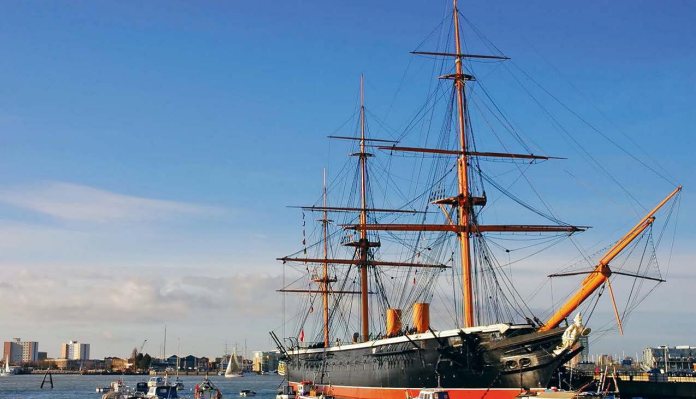HMS Warrior
- Last updated: 22/06/2022

Arms races between nations are nothing new and there are plenty of examples to be found in history dating back millennia. Industrialisation took this struggle for more powerful weaponry to new heights, such as the fight for supremacy at sea in the mid-19th century between Britain and France. It could be argued that France initiated this arms race with the launching of the warship, ‘La Gloire’, in 1858. Powered by steam and sail, it was capable of reaching thirteen knots (15mph) and was protected by armour plate up to 4.7” thick in places, behind which lay 17” of timber. It was unlike any warship which had gone before. Carrying an original armament of 36 muzzle-loading guns of 6.5” calibre, the Royal Navy saw it as a threat.
Britain’s response was the Warrior, work on which began on the 25th May 1859 when she was laid down at the shipyard of the Thames Iron Works and Shipbuilding Company, located at Bow Creek on the River Thames. Work progressed well and on 29th December 1860, she was launched and moved to Victoria Dock to be fitted out. Eight months later, on 1st August 1861, she was commissioned, and a week later she was towed to Greenhithe for her final fitting out. Exactly five weeks later the Warrior was completed and on the 19th of September sailed to Portsmouth where she spent nine months conducting a series of successful sea trials.
In June 1862, three years after being laid down, the Warrior entered service with the Channel Squadron, putting the Royal Navy once more ahead in the naval arms race. With an overall length of 420ft, she was 164ft longer than the Gloire and with a displacement of 9210 tons, she was more than half again as heavy as her rival. To manage her required a crew of 50 officers and 650 other ratings, which included 380 seamen and 75 stokers to shovel coal, when the boilers for the engines were operational, plus 125 Royal Marines. The hull was made up of 18” thick teak planks ‘sandwiched’ between an inner layer of 1/2” thick wrought iron plates and an outer layer of wrought iron plates 4.5” thick.
The side armour extended 213ft along the length of the ship, plus reached 16ft above the waterline and 6ft below it. The effect was to create a floating ‘armoured box’ inside which the crew and ship’s machinery would be protected. The ends of this box were protected by 4” thick wrought iron plates backed by 12” of teak planking.
For conventional sailing, the Warrior was fitted with three masts. These carried 48,400ft² of canvas when full sail was set and would provide speeds up to 13 knots in the right conditions, making the ship comparable in speed to La Gloire using steam engines. Warrior’s engine was a Penn ‘horizontal trunk type’ of 1250HP, which was coal-powered from ten boilers to reach speeds up to 14.3 knots. When using both sail and steam the Warrior could reach 17.5 knots, which could easily outpace La Gloire.
To fuel the boilers, the Warrior carried 850 tons of coal. This was used at the rate of 11 tons per hour when steaming at full speed, meaning there was sufficient for 77 hours. However, to conserve coal the ship usually cruised using conventional sails. This practice saved the coal for use to manoeuvre when engaged in action and extra speed was needed.
Two funnels were fitted midship which could be lowered when not in use. The 10-ton twin-bladed propeller was of an innovative design that could be disengaged and lifted clear of the water, so as not to impair speed when using sails.
When Warrior first entered service she carried a complement of 40 guns comprising 2x 110-Pounder Rifled Breech-Loading (RBL) guns and 4x 40-Pounder RBLs of 4.7” calibre mounted on the upper deck. There were a further 26x 68-Pounder RBL guns and 8x 110-Pounder RBL guns mounted on the gun deck.
The 110-Pounder RBL weighed between 3.6 tons and 4.1 tons, depending on the version, plus measured 8ft-9 in length. It fired a 7” calibre projectile out to 3,500 yards. The 68-Pounder iron gun weighed 4.75 tons and measured 9ft-6 in length and could fire a projectile of 9” calibre out to a range of over 2,000 yards.
Between 1864 and 1867, Warrior’s armament was reduced to 32 guns, including 7” and 8” calibre rifled muzzle-loading types.
Even before the end of the 19th century, the Warrior’s fortunes were beginning to wane and in 1904, she was renamed ‘Vernon III’ and relegated to the torpedo training establishment at Portsmouth Harbour, HMS Vernon, where she remained for 20 years.
In 1929, the Admiralty transferred her to the Llanion Fuel Depot at Pembroke Docks in Milford Haven, Wales and she was given the rather uninspiring title of ‘Hulk C77’. Over the coming year, she served in various capacities, including that of a floating jetty for refuelling ships throughout the Second World War.
Finally, in 1979, the Royal Navy handed the Warrior over to the Maritime Trust to restore her to her former glory and preserve her for historical posterity. She had been in service for 117 years, during which time she had never fired her guns in anger. Was she the deterrent that, along with all the fortifications, prevented a French attack? That’s an interesting point to debate.
In preparation for the Warrior going on public display, a special jetty was built at Portsmouth, where the fully restored warship is today permanently moored as a floating museum of the Royal Navy during the Victorian period. This remarkable ship is in the care of the Warrior Preservation Trust and is open for the General Public to visit and experience what life was like in the Royal Navy during the late 19th century. To help plan your visit to see HMS Warrior, visit www.hmswarrior.org